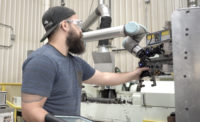Missiles are the premier weapon of modern warfare. According to consulting firm Polaris Market Research, global sales of rockets and missiles are expected to increase from $58.3 billion in 2021 to $73.8 billion in 2026, growing at a cumulative annual rate of 4.8 percent.
Among the world’s leading manufacturers of missiles is MBDA. Headquartered in Le Plessis-Robinson, France, MBDA is jointly owned by Airbus, BAE Systems and Leonardo. The company employs some 14,000 people in six countries. In 2021, the company reported orders worth 5.1 billion euros and a backlog of 17.8 billion euros.
MBDA’s assembly plant in Bourges, France, specializes in the manufacture of tactical missiles. These missiles require both electromechanical assembly and production of metal and composite materials.
To boost throughput and increase health and safety for workers, MBDA wanted to employ robots to automate certain processes for small production runs or even single unit production. Ideally, an operator with no programming skills would be able to quickly teach the robot the process to be carried out. Then, the robot would execute the task without human supervision.
The first task chosen for automation was the process of manually cleaning the molds used to make composite parts. Among other things, the Bourges factory produces a variety of small composite parts that require molds. Each mold must be stripped clean before being used in production. It’s a complex operation. The parts to be molded are diverse and numerous. For each series of parts, the amount of residue to be stripped—and the location of the residue—varies. Performed manually, the task is tedious, and the operator must be protected from exposure to toxic substances.
MBDA engineers believed a six-axis robot equipped with a laser stripping tool could do the job just as well, if not better, as a person. The only issue would be programming the robot for high-mix production.
“At MBDA, we look for agility when it comes to automation,” explains Vincent Rafin, head of the factory of the future initiative at MBDA. “We want to robotize tasks that cause musculoskeletal disorders for our operators. At the same time, however, certain products require low-volume production or even single-piece production, so we need to keep the nonrecurring costs of programming as low as possible.
“Programming a robot to define the trajectories of a laser is not the right approach for small series production. It is time-consuming and costly and must be done by a roboticist.”
For advice, MBDA turned to Meliad, a French company specializing in laser surface preparation and laser stripping technology, and to Stäubli, a multinational manufacturer of SCARA and six-axis robots. The latter recommended Fuzzy Logic Robotics for its universal, visual programming software.
Programming A Laser Stripper On The Fly
Based in Paris, Fuzzy Logic was founded in 2018 by a Franco-American team of engineers specializing in command and control of industrial robots. The company’s flagship product, Fuzzy Studio, is visual, no-code programming and simulation software that is compatible with several major robot brands (ABB, FANUC, KUKA, Stäubli, UR and Yaskawa).
With Fuzzy Studio, there’s no need to learn programming to use a robot. With a no-code user interface, operators can visually interact with the 3D simulated environment, and the robot programs are automatically generated. Users can design, simulate and modify an entire robotic process in a few clicks. Checking for reachability, collisions and cycle time help engineers refine new projects via simulation and thus lower the risk of robotic investments. For existing workcells, engineers can model it in Fuzzy Studio to create a fully functioning digital twin for offline programming.
Using intelligent trajectory generation tools, engineers can automatically generate complex trajectories for a process directly from the 3D parts in the model. The software provides a powerful arsenal of trajectory generators that understand CAD and 3D models and transform hours of painstaking work into a few clicks. These trajectories can be exported for use by the OEM’s robot controller or PLC.
Working with MBDA, Fuzzy Logic developed a new product Repplix, an extension of Fuzzy Studio. A portable learning device, controlled by the operator using his knowledge of the task, teaches the Repplix software how to align the laser stripper with the mold. A monitoring function, performed via a real-time digital twin of the workcell created in Fuzzy Studio, accounts for potential collisions and trajectory feasibility in the robot’s environment. Alert parameters can then be set up. The trajectory capture also includes several stripping process parameters, such as laser triggering and power. The operator, who is not a roboticist, can modify the trajectory and process parameters via a graphical interface, even after the initial teaching phase.
Then, from the digital twin, the cycle is launched and the robot moves with the laser, guided by the accurate capture of the trajectory that it learned from the operator. The speed at which the robot operates is set directly in the software. It can differ from the speed in the teaching phase. The cycle is performed autonomously by the robot, without the need for operator supervision.
The same teaching process, which takes only a few minutes, is repeated for each new series of molds.
Robot Results
The stripping task is executed with millimeter precision. The manual operation is reproduced with ease because the learning device is a representation of the real tool and is not directly linked to the robot. The operator manages the execution and planning of the movement himself using the software and the parametrized alerts.
The time needed to program the mold cleaning operation has been slashed from several hours to a few minutes. Productivity has increased by automating the cleaning operation, and the risks for the operator are reduced. This has made automating the operation profitable, both in terms of safety and economics.
“With Repplix, the robot becomes a precision tool in the hands of the operator,” says Ryan Lober, CEO of Fuzzy Logic. “Our software allows him to automate his task in complete autonomy, without any intervention from a specialist.
“Another advantage is that Repplix is designed to start being used immediately, with no real training required. Our software allows the automation of processes where this has previously been impossible. We have barely finished the initial application, and already, Repplix is being deployed by other users in Europe.”
“This technological building block is duplicable. It will become available for this first use case in the first quarter of 2022,” says Nicolas Gautier, robotics technical lead at MBDA. “We are already working on extending it to cover new applications. For example, sandblasting, painting, welding or waterjet cutting. These applications all have complex trajectories that need to be programmed. With conventional tools, we would need highly qualified personnel and a great deal of time, so programming them would be very costly. Fuzzy Logic and Repplix have now removed this barrier, which prevented the cost-effective automation of such applications.”
Jean-Michel Duchazeaubeneix, CEO of Meliad, says Repplix opens up new opportunities for laser stripping applications: “We offer robotic laser stripping technology, but this technology remains complicated because it has to be done by specialists,” he explains. “Programming a trajectory for low-volume production, as is the case at MBDA, generates prohibitively high nonrecurring costs that directly kill the project. Repplix offers us the possibility of rapidly and easily deploying our laser technology across a wide range of repair or maintenance applications that have been difficult to implement until now.”
For more information on robot programming software, visit https://flr.io.
For more information on laser stripping technology, visit www.meliad-sas.com.








